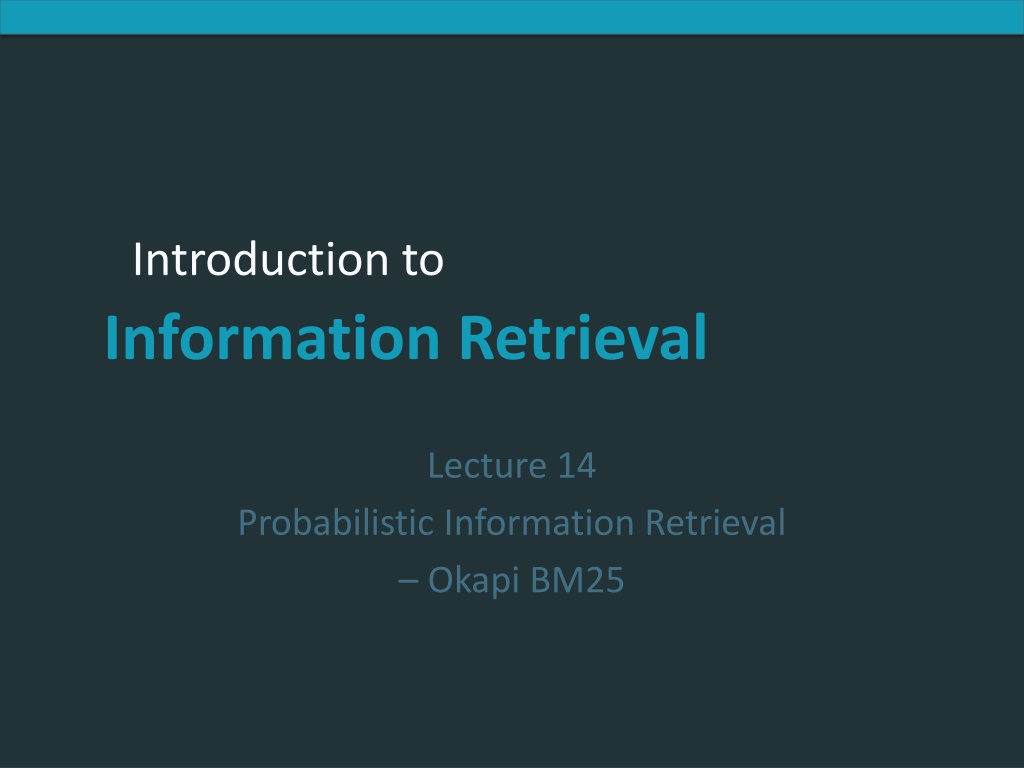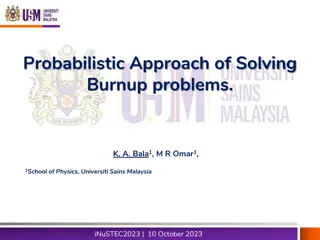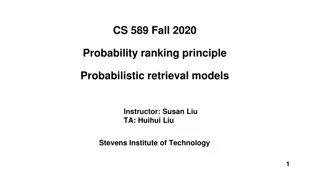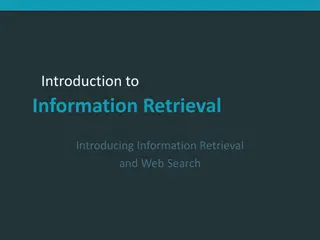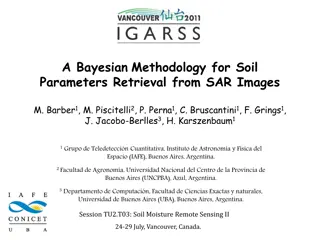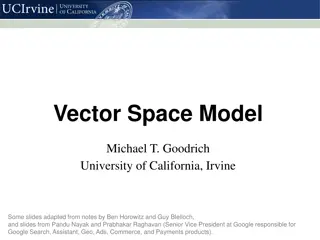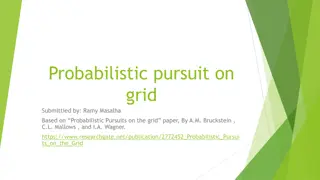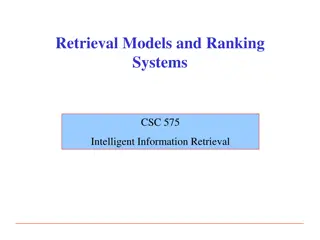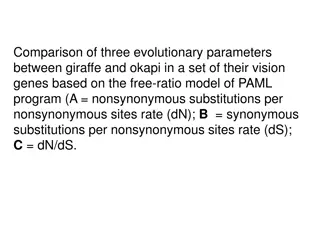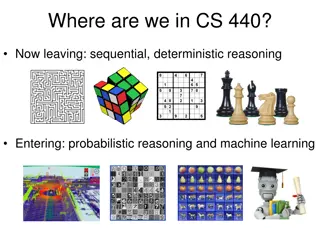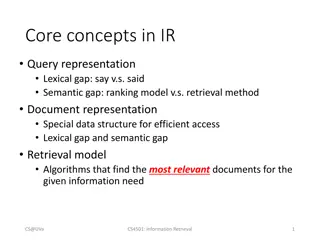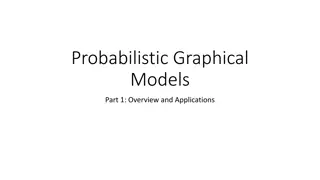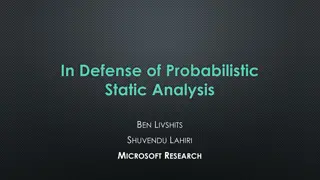Understanding Probabilistic Information Retrieval: Okapi BM25 Model
Probabilistic Information Retrieval plays a critical role in understanding user needs and matching them with relevant documents. This introduction explores the significance of using probabilities in Information Retrieval, focusing on topics such as classical probabilistic retrieval models, Okapi BM25, Bayesian networks, and language model approaches. The document ranking problem is discussed, emphasizing the importance of ranking documents by the probability of relevance to the user query. The basics of probabilities, Bayes' Rule, and the Probability Ranking Principle are also covered.
Download Presentation

Please find below an Image/Link to download the presentation.
The content on the website is provided AS IS for your information and personal use only. It may not be sold, licensed, or shared on other websites without obtaining consent from the author. Download presentation by click this link. If you encounter any issues during the download, it is possible that the publisher has removed the file from their server.
E N D
Presentation Transcript
Introduction to Information Retrieval Introduction to Information Retrieval Lecture 14 Probabilistic Information Retrieval Okapi BM25
Introduction to Information Retrieval Why probabilities in IR? Understanding of user need is uncertain User Query Information Need Representation How to match? Uncertain guess of whether document has relevant content Document Representation Documents In vector space model (VSM), matching between each document and query is attempted in a semantically imprecise space of index terms. Probabilities provide a principled foundation for uncertain reasoning. Can we use probabilities to quantify our uncertainties?
Introduction to Information Retrieval Probabilistic IR topics Classical probabilistic retrieval model Probability ranking principle, etc. Binary independence model ( Na ve Bayes text cat) (Okapi) BM25 Bayesian networks for text retrieval Language model approach to IR An important emphasis in recent work Probabilistic methods are one of the oldest but also one of the currently hottest topics in IR.
Introduction to Information Retrieval The document ranking problem We have a collection of documents User issues a query A list of documents needs to be returned Ranking method is the core of an IR system: In what order do we present documents to the user? We want the best document to be first, second best second, etc . Idea: Rank by probability of relevance of the document w.r.t. information need P(R=1|documenti, query)
Introduction to Information Retrieval Recall a few probability basics For events A and B: Bayes Rule p(A,B)= p(A B)= p(A|B)p(B)= p(B| A)p(A) Prior p(A|B)=p(B| A)p(A) p(B| A)p(A) p(B| X)p(X) X=A,A = p(B) Posterior O(A)=p(A) p(A) 1- p(A) p(A)= Odds:
Introduction to Information Retrieval Probability Ranking Principle Let x represent a document in the collection. Let R represent relevance of a document w.r.t. given (fixed) query and let R=1 represent relevant and R=0 not relevant. Need to find p(R=1|x)- probability that a document x is relevant. p(R=1),p(R=0) - prior probability of retrieving a relevant or non-relevant document p(R=1| x)=p(x|R =1)p(R =1) p(x) p(R= 0| x)=p(x |R= 0)p(R= 0) p(x|R=1), p(x|R=0) - probability that if a relevant (not relevant) document is retrieved, it is x. p(x) p(R=0|x)+ p(R=1| x)=1
Introduction to Information Retrieval Probability Ranking Principle How do we compute all those probabilities? Do not know exact probabilities, have to use estimates Binary Independence Model (BIM) which we discuss next is the simplest model Questionable assumptions Relevance of each document is independent of relevance of other documents. Really, it s bad to keep on returning duplicates term independence assumption terms contributions to relevance are treated as independent events.
Introduction to Information Retrieval Probabilistic Retrieval Strategy Estimate how terms contribute to relevance How do things like tf, df, and document length influence your judgments about document relevance? A more nuanced answer is the Okapi formulae Sp rck Jones / Robertson Combine to find document relevance probability Order documents by decreasing probability
Introduction to Information Retrieval Probabilistic Ranking Basic concept: For a given query, if we know some documents that are relevant, terms that occur in those documents should be given greater weighting in searching for other relevant documents. By making assumptions about the distribution of terms and applying Bayes Theorem, it is possible to derive weights theoretically. Van Rijsbergen
Introduction to Information Retrieval Binary Independence Model Traditionally used in conjunction with PRP Binary = Boolean: documents are represented as binary incidence vectors of terms: iff term i is present in document x. Independence : terms occur in documents independently Different documents can be modeled as the same vector = = (1 x 1 , , ) x ix nx
Introduction to Information Retrieval Binary Independence Model Queries: binary term incidence vectors Given query q, for each document d need to compute p(R|q,d). replace with computing p(R|q,x) where xis binary term incidence vector representing d. Interested only in ranking Will use odds and Bayes Rule: p(R=1|q)p(x |R=1,q) p(x |q) p(R= 0|q)p(x |R=0,q) p(x |q) O(R|q,x)=p(R=1|q,x) p(R= 0|q,x)=
Introduction to Information Retrieval Binary Independence Model O(R|q,x)=p(R=1|q,x) p(R=0|q,x)=p(R=1|q) p(R=0|q) p(x |R=1,q) p(x |R=0,q) Constant for a given query Needs estimation Using Independence Assumption: p(x |R=1,q) p(x |R=0,q)= p(xi|R=1,q) p(xi|R=0,q) n i=1 p(xi|R=1,q) p(xi|R=0,q) n O(R|q,x)=O(R|q) i=1
Introduction to Information Retrieval Binary Independence Model p(xi|R=1,q) p(xi|R=0,q) n O(R|q,x)=O(R|q) i=1 Since xiis either 0 or 1: O(R|q,x)=O(R|q) p(xi=1|R=1,q) p(xi=1|R=0,q) p(xi=0|R=1,q) p(xi=0|R=0,q) xi=1 xi=0 Let pi= p(xi=1|R=1,q); ri= p(xi=1|R=0,q); p = r Assume, for all terms not occurring in the query (qi=0) i i (1- pi) (1-ri) pi ri O(R|q,x)=O(R|q) xi=1 qi=1 xi=0 qi=1
Introduction to Information Retrieval document relevant (R=1) not relevant (R=0) term present xi = 1 xi = 0 pi (1 pi) ri (1 ri) term absent
Introduction to Information Retrieval Binary Independence Model 1- pi 1-ri pi ri O(R|q,x)=O(R|q) xi=qi=1 xi=0 qi=1 All matching terms Non-matching query terms 1- pi 1-ri 1-ri 1- pi 1- pi 1-ri pi ri O(R|q,x)=O(R|q) xi=1 qi=1 xi=1 qi=1 xi=0 qi=1 pi(1-ri) ri(1- pi) 1- pi 1-ri O(R|q,x)=O(R|q) xi=qi=1 qi=1 All matching terms All query terms
Introduction to Information Retrieval Binary Independence Model 1 ( i p ) 1 r p = i q x = i q = ( | , ) ( | ) i i O R q x O R q 1 ( i r ) 1 p r = 1 1 i i i Constant for each query Only quantity to be estimated for rankings Retrieval Status Value: 1 ( i p ) 1 ( i p ) r r = q = i q x = = log log i i RSV 1 ( i r ) 1 ( i r ) p p = = 1 x 1 i i i i i
Introduction to Information Retrieval Binary Independence Model All boils down to computing RSV. 1 ( i p ) 1 ( i p ) r r = q = i q x = = log log i i RSV 1 ( i r ) 1 ( i r ) p p = = 1 r x 1 i i i i i 1 ( i p ) = = = ; RSV ic log i c i 1 ( i r ) p = 1 i q x i i The ci are log odds ratios They function as the term weights in this model So, how do we compute ci s from our data ?
Introduction to Information Retrieval Binary Independence Model Estimating RSV coefficients in theory For each term i look at this table of document counts: Documents xi=1 s xi=0 S-s Relevant Non-Relevant Total n-s n N-n-S+s N-n Total S N-S N ( N ) n s s Estimates: pi ri s ( ) S ( N S ) S s = ( , , , ) log ci K N n S s + ( ) ( ) n s n S s
Introduction to Information Retrieval Estimation key challenge If non-relevant documents are approximated by the whole collection, then ri(prob. of occurrence in non-relevant documents for query) is n/N and log1-ri = logN -n-S+s logN -n logN = IDF! n-s ri n n
Introduction to Information Retrieval Estimation key challenge pi (probability of occurrence in relevant documents) cannot be approximated as easily pi can be estimated in various ways: from relevant documents if know some Relevance weighting can be used in a feedback loop constant (Croft and Harper combination match) then just get idf weighting of terms (with pi=0.5) RSV = xi=qi=1 logN ni proportional to prob. of occurrence in collection Greiff (SIGIR 1998) argues for 1/3 + 2/3 dfi/N
Introduction to Information Retrieval Probabilistic Relevance Feedback 1. Guess a preliminary probabilistic description of R=1 documents and use it to retrieve a first set of documents 2. Interact with the user to refine the description: learn some definite members with R=1 and R=0 3. Reestimate pi and ri on the basis of these
Introduction to Information Retrieval Iteratively estimating pi and ri (= Pseudo-relevance feedback) 1. Assume that pi is constant over all xiin query and ri as before pi = 0.5 (even odds) for any given doc 2. Determine guess of relevant document set: V is fixed size set of highest ranked documents on this model 3. We need to improve our guesses for pi and ri, so Use distribution of xi in docs in V. Let Vi be set of documents containing xi pi = |Vi| / |V| Assume if not retrieved then not relevant ri = (ni |Vi|) / (N |V|) 4. Go to 2. until converges then return ranking 22
Introduction to Information Retrieval Okapi BM25: A Non-binary Model The BIM was originally designed for short catalog records of fairly consistent length, and it works reasonably in these contexts For modern full-text search collections, a model should pay attention to term frequency and document length BestMatch25 (a.k.a BM25 or Okapi) is sensitive to these quantities From 1994 until today, BM25 is one of the most widely used and robust retrieval models 23
Introduction to Information Retrieval Okapi BM25: A Nonbinary Model The simplest score for document d is just idf weighting of the query terms present in the document: Improve this formula by factoring in the term frequency and document length: tf td : term frequency in document d Ld (Lave): length of document d (average document length in the whole collection) k1: tuning parameter controlling the document term frequency scaling b: tuning parameter controlling the scaling by document length 24
Introduction to Information Retrieval Saturation function For high values of k1, increments in tfi continue to contribute significantly to the score Contributions tail off quickly for low values of k1
Introduction to Information Retrieval Document length normalization
Introduction to Information Retrieval Okapi BM25: A Nonbinary Model If the query is long, we might also use similar weighting for query terms tf tq: term frequency in the query q k3: tuning parameter controlling term frequency scaling of the query No length normalisation of queries (because retrieval is being done with respect to a single fixed query) The above tuning parameters should ideally be set to optimize performance on a development test collection. In the absence of such optimisation, experiments have shown reasonable values are to set k1 and k3 to a value between 1.2 and 2 and b = 0.75 27
